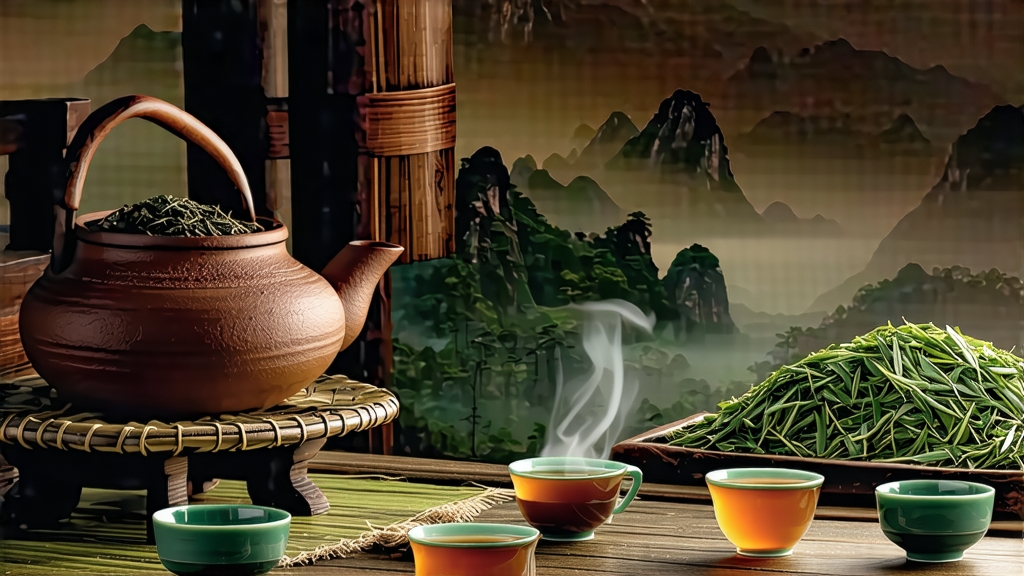
Tucked away in the humid, karst-pitted mountains of southern Guangxi, Liu Bao tea has spent four centuries quietly perfecting the art of controlled fermentation while its more famous cousin, Pu-er, soaked up the global spotlight. To international drinkers who equate “dark tea” solely with Yunnan’s shou Pu-er, Liu Bao arrives as a revelation—an earthier, sweeter, more camphorous brew that once greased the wheels of the legendary Tea Horse Road and still carries the scent of horse sweat, camphor wood and betel nut in every cup. This article invites you to journey from the Qing-dynasty wharves of Wuzhou to the modern gongfu table, unpacking the history, craft, and sensory code of a tea that refuses to hurry.
-
Historical footprints in misty mountains
Liu Bao literally means “Six Forts,” a reference to the six defensive stockades established around the tiny township of Liu Bao in Cangwu County during the Ming dynasty. By the early Qing, the same stockades had become trading posts where Yao and Han farmers barreled their rough, sun-withered leaves onto bamboo rafts that floated down the Liujiang River toward the Pearl Delta and, eventually, British Hong Kong. The British East India Company records of 1796 list “Loobow” as one of the cheapest “black teas” (the term then covered all fully fermented leaves) auctioned in London, appreciated by dockworkers for its dark color and low price. Meanwhile, Malaysian tin miners learned that Liu Bao’s alkaline liquor soothed the silica-laden lungs of coolies; whole tongs of leaf were packed into rattan baskets, loaded onto steamers at Port Swettenham, and carried across the South China Sea. Thus Liu Bao became the first Chinese tea to develop a cult following outside China—decades before Pu-er ever left Yunnan. -
Terroir: where rock, river and humidity conspire
The Liu Bao micro-region sits at 23–24 °N, 200–500 m above sea level, where granite peaks force warm, moisture-laden air upward, creating 80 % relative humidity year-round. The soil is a well-drained, slightly acidic laterite rich in iron and potassium—ideal for the large-leaf Camellia sinensis var. assamica bushes that have seeded themselves here since the Jurassic. Locals insist that three nights of mountain fog equal one day of sun in terms of leaf chemistry; the slow photosynthesis builds thick cell walls packed with polyphenols and amino acids that later surrender to microbial magic. -
From leaf to lianhua: the craft in seven acts
Unlike Pu-er, Liu Bao is never pressed into cakes; it remains a loose-leaf tea whose identity is forged in bamboo baskets that breathe. The traditional seven-step sequence has been inscribed as Guangxi provincial intangible heritage:
a) Picking: only the “zhong kai mian” standard—one bud with the third or fourth mature leaf—is taken between Qingming and Grain Rain. The extra petiole length carries more pectin, crucial for later stickiness.
b) Shai qing (sun withering): leaves are spread on split-bamboo mats for 3–4 hours until they lose 15 % moisture and the grassy note subsides.
c) Sha qing (kill-green): wok firing at 160 °C for four minutes deactivates 80 % of oxidative enzymes, but the thick leaves retain enough for microbial re-activation later.
d) Rou nian (rolling): a 30-minute rolling under hemp cloth breaks cell walls without shredding; the leaf strips emerge as tight cords the width of a chopstick.
e) Dui wo (piling): the critical step that earns Liu Bao its “dark” status. The damp strips are heaped 70 cm high, covered with wet gunny sacks, and left in a steamed room at 28 °C, 85 % RH. For the next 20–30 days the pile is turned every 48 hours, allowing a consortium of Aspergillus niger, Blastobotrys adeninivorans and local Candida yeast to raise the temperature to 45 °C. The leaves darken, develop a betel-nut aroma, and acquire the glossy, chestnut-brown color